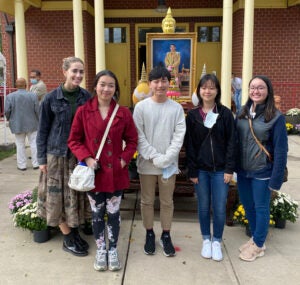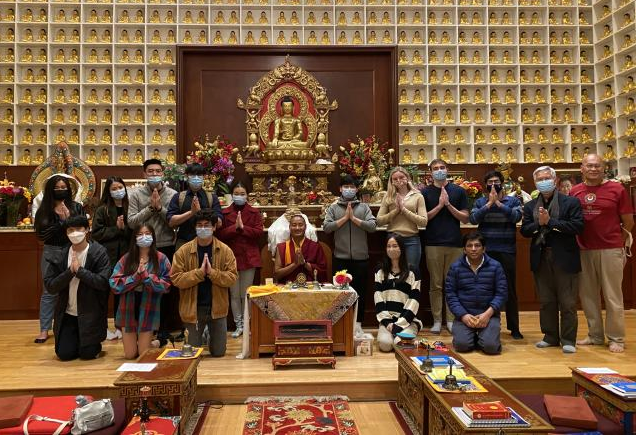Buddhist Student Association: Creating a Presence at Georgetown
 Earlier this semester, the Buddhist Student Association (BuSA) organized three temple visits, not wanting to favor any branch of Buddhism over the other we decided to visit temples that represent the three main branches of Buddhism: Theravada, Mahayana, and Vajrayana. We visited a Thai (Theravada) in collaboration with GUThai, a Japanese (Mahayana) temple in collaboration with J-NET, and a Tibetan (Vajrayana) temple and hope to arrange temple visits representing the three major traditions in the spring as well.
Earlier this semester, the Buddhist Student Association (BuSA) organized three temple visits, not wanting to favor any branch of Buddhism over the other we decided to visit temples that represent the three main branches of Buddhism: Theravada, Mahayana, and Vajrayana. We visited a Thai (Theravada) in collaboration with GUThai, a Japanese (Mahayana) temple in collaboration with J-NET, and a Tibetan (Vajrayana) temple and hope to arrange temple visits representing the three major traditions in the spring as well.
I strongly believe that the temple visits are important to Georgetown’s student body whether they are Buddhist or simply interested in Buddhist teachings. It’s a great way for students to form bonds while spending time together learning about the rituals, teachings, and atmosphere of Buddhism and the different temples.
Our first visit was to the Thai temple, Wat Yarnna Rangsee Buddhist Monastery in Sterling, Virginia (pictured above). This visit also coincided with Kathina, a festival in which Buddhists offer their gratitude to Buddhist monks, providing donations and most visibly, new robes for the monks. We were completely consumed by the experience. Visually, we were surrounded by Thai-style buildings, monks, golden statues, and people wearing traditional clothing. Music and people speaking in Thai could be heard throughout the temple. Prior to the ceremony, we joined the rest of the laity in sharing what was perhaps the most delicious meal I have had this semester. Providing monks with gifts alongside other members of the laity was a moving experience; I only wish we had enough time to also provide them with robes!
 Our second visit took us to the Ekoji Buddhist Temple in Fairfax, Virginia. The interior of Ekoji the “Temple of the Gift of Light” was simple, beautiful, and meaningful in its layout. Noticeably absent was a statue of the Buddha. Reverend Hayashi, the temple’s residential minister since 2016, explained that he preferred to simply have the name of Amitabha Buddha. He gave us a short special service and answered our questions about Buddhism. Reverend Hayashi also discussed the changes the Temple made to cater to Americans; most visibly we sat in chairs in rows similar to pews (pictured above). The Japanese students among us also talked to him about what it was like practicing Buddhism in the United States.
Our second visit took us to the Ekoji Buddhist Temple in Fairfax, Virginia. The interior of Ekoji the “Temple of the Gift of Light” was simple, beautiful, and meaningful in its layout. Noticeably absent was a statue of the Buddha. Reverend Hayashi, the temple’s residential minister since 2016, explained that he preferred to simply have the name of Amitabha Buddha. He gave us a short special service and answered our questions about Buddhism. Reverend Hayashi also discussed the changes the Temple made to cater to Americans; most visibly we sat in chairs in rows similar to pews (pictured above). The Japanese students among us also talked to him about what it was like practicing Buddhism in the United States.
 The last temple we visited this semester was The Drikung Dharma Surya Center, a Tibetan temple also located in Fairfax, Virginia. The inside of the temple was beautiful, and hundreds of golden Buddhas (pictured above) surrounded us while Khenpo Samdup Rinpoche talked to us about Vajrayana Buddhism. Perhaps the most memorable part of this visit was the opportunity to turn the prayer wheel located outside the temple, a stunning golden masterpiece that, according to them, is one of only two in the entire United States, the other being on the West Coast.
The last temple we visited this semester was The Drikung Dharma Surya Center, a Tibetan temple also located in Fairfax, Virginia. The inside of the temple was beautiful, and hundreds of golden Buddhas (pictured above) surrounded us while Khenpo Samdup Rinpoche talked to us about Vajrayana Buddhism. Perhaps the most memorable part of this visit was the opportunity to turn the prayer wheel located outside the temple, a stunning golden masterpiece that, according to them, is one of only two in the entire United States, the other being on the West Coast.
These temple visits are just the start of creating a permanent and strong presence for the sangha on the Georgetown campus. I sincerely hope that temple visits will be a regular staple for BuSA members in the future, giving Georgetown students every year the opportunity to experience a Buddhist service in a Buddhist environment.
Finally, I would like to thank all those who helped make the temple visits happen. In particular, Diana Brown, Assistant Director for Interreligious Engagement in Campus Ministry as well as Professor B. N. Hebbar, Executive Vice-President, International Buddhist Association of America (IBAA).
By Jessup Kim.
Jessup is a senior in the School of Foreign Service and Co-President of the Buddhist Student Association.